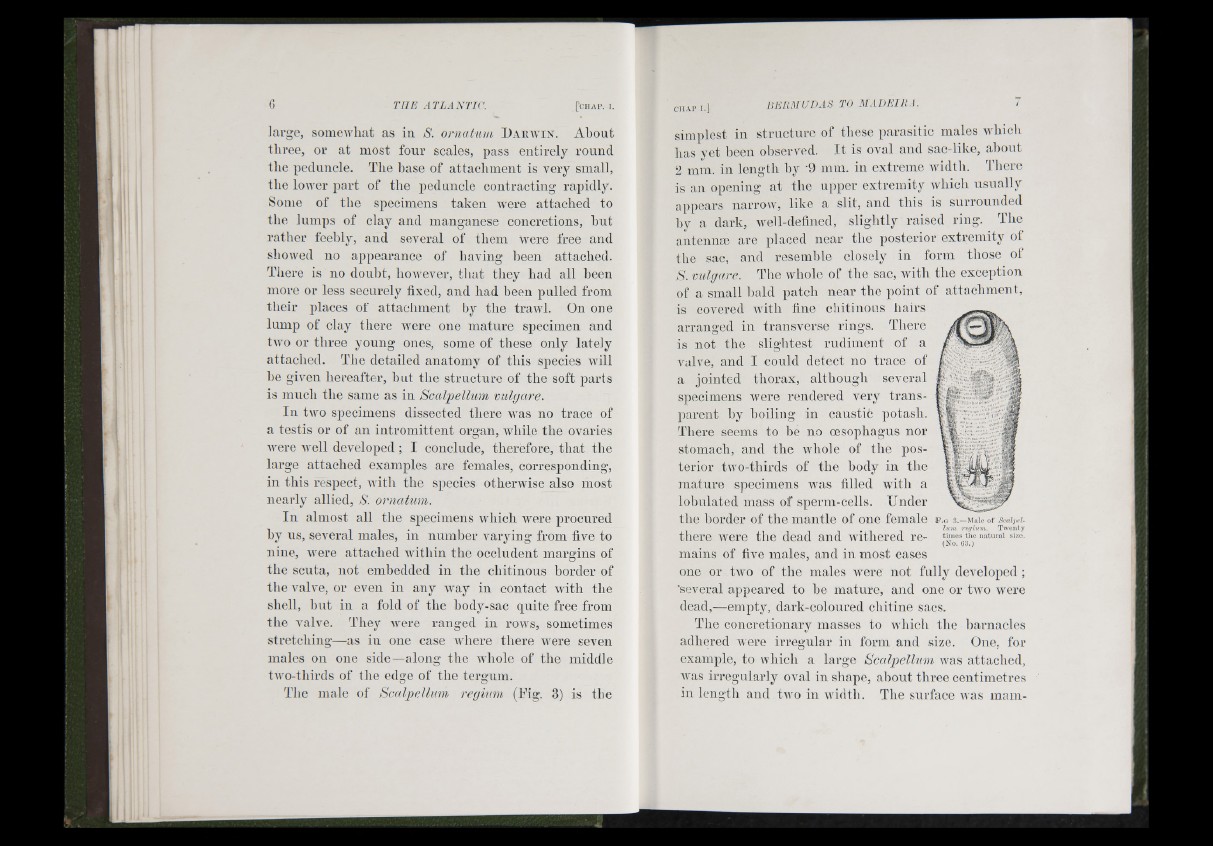
large, somewhat as in S. ornatum D a r w i n . Ahont
three, or at most four scales, pass entirely round
the pednncle. The base of attachment is very small,
the lower part of the peduncle contracting rapidly.
Some of the specimens taken Avere attached to
the lamps of clay and manganese concretions, hut
rather feebly, and several of them AAvre free and
showed no appearance of having been attached.
There is no doubt, hoAvever, th at they had all been
more or less securely fixed, and liad been pulled from
their places of attachment by the traAvl. On one
lump of clay there AA’ere one mature specimen and
tAvo or three young ones, some of these only lately
attached. Tlie detailed anatomy of this species Avill
he given hereafter, hut the structure of the soft parts
is much the same as in Scalpellum vulgare.
In two specimens dissected there Avas no trace of
a testis or of an intromittent organ, AAdiile the ovaries
Avere Avell developed ; I conclude, therefore, that the
large attached examples are females, corresponding,
in this respect, Avith the species otherAvise also most
nearly allied, S. ornatum.
In almost all the specimens Avdiicli AA^ere procured
by us, several males, in number varying from five to
nine, Avere attached Avithin the occludent margins of
the scuta, not embedded in the cliitinous border of
tlie valve, or even in any Avay in contact Avith the
shell, hut in a fold of the body-sac quite free from
the A’alve. They AA^ere ranged in roAvs, sometimes
stretching—as in one case where there AA^ere seven
males on one side—along the Avhole of the middle
two-thirds of the edge of the tergum.
The male of Scalpellum regvum (Fig. 3) is the
simplest in structure of these parasitic males Avliich
has vet been observed. It is oval and sac-like, about
2 mill, in length hy 9 mm. in extreme Avidth. There
is an opening at the upper extremity Avhicli usually
appears narrow, like a slit, and this is surrounded
hy a dark, Avell-defined, slightly raised ring. Tlie
antennm are placed near the posterior extremity of
the sac, and resemlile closely in form those of
S. vulgare. The whole of the sac, Avith the exception
of a small bald patch near the point of attachment,
is covered Avith fine cliitinous hairs
arranged in transverse rings. There
is not the slightest rudiment of a
AuiAe, and I could detect no trace of
a jointed thorax, although several
specimens Avere rendered very tran s parent
hy boiling in caustic potash.
There seems to be no oesophagus nor
stomach, and the Avhole of the posterior
two-thirds of the body in the
mature specimens aai-is filled with a
lohnlated mass of sperm-cells. Under
the border of the mantle of one female f.g .s.-Maieot
1 . , 1 1 regivm. Twenty there Avere the dead and withered re- time.stjie natural .size. (No. 6.3.)
mains of five males, and in most cases
one or tAvo of the males Avere not fully developed ;
'several appeared to he mature, and one or tAvo Avere
dead,—empty, dark-coloured chitine sacs.
The concretionary masses to Avliich the barnacles
adhered AAere irregular in form and size. One. for
example, to which a large Scalpellum was attached,
Avas irregularly oval in shape, about three centimetres
in length and tAvo in Avidtli. The surface Avas mam